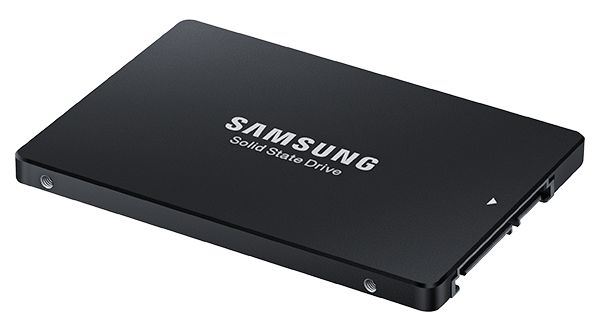1424 -- -- -- -- 4 

2.5IN PM1633A 3.84TB CP SAS SS ThinkSystem 6.35 cm (2.5" ) PM1633a, 3.84 TB, Capacity SAS... more
2.5IN PM1633A 3.84TB CP SAS SS ThinkSystem 6.35 cm (2.5" ) PM1633a, 3.84 TB, Capacity SAS 12Gb, Hot Swap, SSD
The PM1633a Enterprise Capacity SSDs have the following features:
- High capacity server SSD suitable for read-intensive workloads
- Based on Samsung V-NAND technology and TLC flash memory
- Endurance of 1 drive-write per day (DWPD) over 5 years
- 2.5-inch or 3.5-inch industry standard form factor with hot-swap tray
- SAS 12 Gbps interface
- Active-active dual port host interface
- Protect data integrity from unexpected power loss with Samsung's advanced power-loss protection architecture
- Supports Self-Monitoring, Analysis and Reporting Technology (S.M.A.R.T)
- End-to-end data protection
- Support 16 Initiator with Tag Command Queuing (TCQ) Command Set with a queue-depth of up to 128 commands
- Compliant with SCSI Specification (SAS-3 / SPL-3 / SBC-4 / SPC-4 / SAM-5)
- RoHS Compliant
Enterprise Capacity SSDs have similar read and write IOPS performance and similar endurance to Enterprise Entry SSDs, however, the key difference is density - the total amount of storage in each 2.5-inch drive. With large configurations, more storage can be installed internal to the server, changing the need for external JBOD connections thereby saving power and rack space.
SSD write endurance is typically measured by the number of program/erase (P/E) cycles that the drive incurs over its lifetime, listed as the total bytes of written data (TBW) in the device specification. The TBW value assigned to a solid-state device is the total bytes of written data (based on the number of P/E cycles) that a drive can be guaranteed to complete (% of remaining P/E cycles = % of remaining TBW).
Reaching this limit does not cause the drive to immediately fail. It simply denotes the maximum number of writes that can be guaranteed. A solid-state device will not fail upon reaching the specified TBW. At some point based on manufacturing variance margin, after surpassing the TBW value, the drive will reach the end-of-life point, at which the drive will go into a read-only mode.
For example, the PM1633a 7.68 TB drive has an endurance of 14,016 TB of total bytes written (TBW). This means that for full operation over five years, write workload can be up to 7,680 GB of writes per day, which is equivalent to 1.0 full drive writes per day (DWPD). For the device to last three years, the drive write workload can be up to 12,800 GB of writes per day, which is equivalent to 1.7 full drive writes per day.
Users also have the flexibility to use this drive for more write intensive applications because these drives have such a large average daily write capacity. For example, the 3.84 TB has the same average daily write capacity (7,008 TB at 1.0 drive writes per day) as a 400 GB Enterprise Performance drive (7,300 TB at 10 drive writes per day).
The PM1633a Enterprise Capacity SSDs have the following features:
- High capacity server SSD suitable for read-intensive workloads
- Based on Samsung V-NAND technology and TLC flash memory
- Endurance of 1 drive-write per day (DWPD) over 5 years
- 2.5-inch or 3.5-inch industry standard form factor with hot-swap tray
- SAS 12 Gbps interface
- Active-active dual port host interface
- Protect data integrity from unexpected power loss with Samsung's advanced power-loss protection architecture
- Supports Self-Monitoring, Analysis and Reporting Technology (S.M.A.R.T)
- End-to-end data protection
- Support 16 Initiator with Tag Command Queuing (TCQ) Command Set with a queue-depth of up to 128 commands
- Compliant with SCSI Specification (SAS-3 / SPL-3 / SBC-4 / SPC-4 / SAM-5)
- RoHS Compliant
Enterprise Capacity SSDs have similar read and write IOPS performance and similar endurance to Enterprise Entry SSDs, however, the key difference is density - the total amount of storage in each 2.5-inch drive. With large configurations, more storage can be installed internal to the server, changing the need for external JBOD connections thereby saving power and rack space.
SSD write endurance is typically measured by the number of program/erase (P/E) cycles that the drive incurs over its lifetime, listed as the total bytes of written data (TBW) in the device specification. The TBW value assigned to a solid-state device is the total bytes of written data (based on the number of P/E cycles) that a drive can be guaranteed to complete (% of remaining P/E cycles = % of remaining TBW).
Reaching this limit does not cause the drive to immediately fail. It simply denotes the maximum number of writes that can be guaranteed. A solid-state device will not fail upon reaching the specified TBW. At some point based on manufacturing variance margin, after surpassing the TBW value, the drive will reach the end-of-life point, at which the drive will go into a read-only mode.
For example, the PM1633a 7.68 TB drive has an endurance of 14,016 TB of total bytes written (TBW). This means that for full operation over five years, write workload can be up to 7,680 GB of writes per day, which is equivalent to 1.0 full drive writes per day (DWPD). For the device to last three years, the drive write workload can be up to 12,800 GB of writes per day, which is equivalent to 1.7 full drive writes per day.
Users also have the flexibility to use this drive for more write intensive applications because these drives have such a large average daily write capacity. For example, the 3.84 TB has the same average daily write capacity (7,008 TB at 1.0 drive writes per day) as a 400 GB Enterprise Performance drive (7,300 TB at 10 drive writes per day).
| Name | Lenovo |
| Street | Meitnersr. 9 |
| Zip code | 70563 |
| City | Stuttgart |
| Phone | +49711 65690807 |
| E-mail/Contact form | Fragen_DE@lenovo.com |
| Website | www.lenovo.com |






